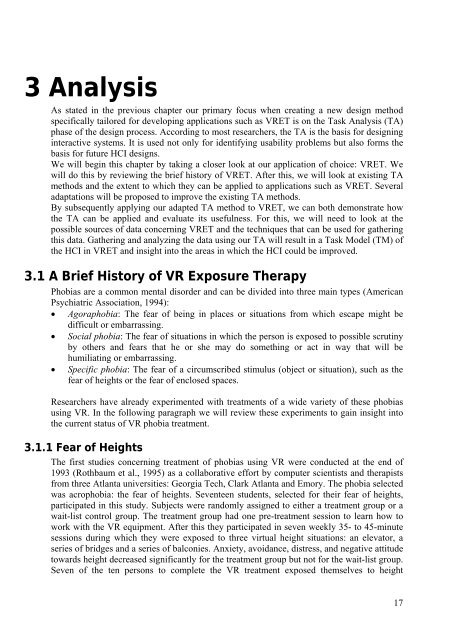Human-Computer Interaction and Presence in Virtual Reality
Human-Computer Interaction and Presence in Virtual Reality
Human-Computer Interaction and Presence in Virtual Reality
Create successful ePaper yourself
Turn your PDF publications into a flip-book with our unique Google optimized e-Paper software.
3 Analysis<br />
As stated <strong>in</strong> the previous chapter our primary focus when creat<strong>in</strong>g a new design method<br />
specifically tailored for develop<strong>in</strong>g applications such as VRET is on the Task Analysis (TA)<br />
phase of the design process. Accord<strong>in</strong>g to most researchers, the TA is the basis for design<strong>in</strong>g<br />
<strong>in</strong>teractive systems. It is used not only for identify<strong>in</strong>g usability problems but also forms the<br />
basis for future HCI designs.<br />
We will beg<strong>in</strong> this chapter by tak<strong>in</strong>g a closer look at our application of choice: VRET. We<br />
will do this by review<strong>in</strong>g the brief history of VRET. After this, we will look at exist<strong>in</strong>g TA<br />
methods <strong>and</strong> the extent to which they can be applied to applications such as VRET. Several<br />
adaptations will be proposed to improve the exist<strong>in</strong>g TA methods.<br />
By subsequently apply<strong>in</strong>g our adapted TA method to VRET, we can both demonstrate how<br />
the TA can be applied <strong>and</strong> evaluate its usefulness. For this, we will need to look at the<br />
possible sources of data concern<strong>in</strong>g VRET <strong>and</strong> the techniques that can be used for gather<strong>in</strong>g<br />
this data. Gather<strong>in</strong>g <strong>and</strong> analyz<strong>in</strong>g the data us<strong>in</strong>g our TA will result <strong>in</strong> a Task Model (TM) of<br />
the HCI <strong>in</strong> VRET <strong>and</strong> <strong>in</strong>sight <strong>in</strong>to the areas <strong>in</strong> which the HCI could be improved.<br />
3.1 A Brief History of VR Exposure Therapy<br />
Phobias are a common mental disorder <strong>and</strong> can be divided <strong>in</strong>to three ma<strong>in</strong> types (American<br />
Psychiatric Association, 1994):<br />
• Agoraphobia: The fear of be<strong>in</strong>g <strong>in</strong> places or situations from which escape might be<br />
difficult or embarrass<strong>in</strong>g.<br />
• Social phobia: The fear of situations <strong>in</strong> which the person is exposed to possible scrut<strong>in</strong>y<br />
by others <strong>and</strong> fears that he or she may do someth<strong>in</strong>g or act <strong>in</strong> way that will be<br />
humiliat<strong>in</strong>g or embarrass<strong>in</strong>g.<br />
• Specific phobia: The fear of a circumscribed stimulus (object or situation), such as the<br />
fear of heights or the fear of enclosed spaces.<br />
Researchers have already experimented with treatments of a wide variety of these phobias<br />
us<strong>in</strong>g VR. In the follow<strong>in</strong>g paragraph we will review these experiments to ga<strong>in</strong> <strong>in</strong>sight <strong>in</strong>to<br />
the current status of VR phobia treatment.<br />
3.1.1 Fear of Heights<br />
The first studies concern<strong>in</strong>g treatment of phobias us<strong>in</strong>g VR were conducted at the end of<br />
1993 (Rothbaum et al., 1995) as a collaborative effort by computer scientists <strong>and</strong> therapists<br />
from three Atlanta universities: Georgia Tech, Clark Atlanta <strong>and</strong> Emory. The phobia selected<br />
was acrophobia: the fear of heights. Seventeen students, selected for their fear of heights,<br />
participated <strong>in</strong> this study. Subjects were r<strong>and</strong>omly assigned to either a treatment group or a<br />
wait-list control group. The treatment group had one pre-treatment session to learn how to<br />
work with the VR equipment. After this they participated <strong>in</strong> seven weekly 35- to 45-m<strong>in</strong>ute<br />
sessions dur<strong>in</strong>g which they were exposed to three virtual height situations: an elevator, a<br />
series of bridges <strong>and</strong> a series of balconies. Anxiety, avoidance, distress, <strong>and</strong> negative attitude<br />
towards height decreased significantly for the treatment group but not for the wait-list group.<br />
Seven of the ten persons to complete the VR treatment exposed themselves to height<br />
17
















